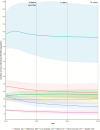Ending the Epidemic in America Will Not Happen if the Status Quo Continues: Modeled Projections for Human Immunodeficiency Virus Incidence in 6 US Cities
- PMID: 31609446
- PMCID: PMC7348133
- DOI: 10.1093/cid/ciz1015
Ending the Epidemic in America Will Not Happen if the Status Quo Continues: Modeled Projections for Human Immunodeficiency Virus Incidence in 6 US Cities
Abstract
We estimated 10-year (2020-2030) trajectories for human immunodeficiency virus incidence in 6 US cities. Estimated incidence will only decrease in 2 of 6 cities, with the overall population-weighted incidence decreasing 3.1% (95% credible interval [CrI], -1.0% to 8.5%) by 2025, and 4.3% (95% CrI, -2.6% to 12.7%) by 2030 across cities. Targeted, context-specific combination implementation strategies will be necessary to meet the newly established national targets.
Keywords: HIV/AIDS; dynamic transmission model; epidemiological projection; “Ending the HIV epidemic” plan.
© The Author(s) 2019. Published by Oxford University Press for the Infectious Diseases Society of America. All rights reserved. For permissions, e-mail: journals.permissions@oup.com.
Figures

Comment in
-
Ending the Human Immunodeficiency Virus Epidemic: Towards an Evidence-Based Approach.Clin Infect Dis. 2019 Nov 27;69(12):2199-2200. doi: 10.1093/cid/ciz1018. Clin Infect Dis. 2019. PMID: 31609445 No abstract available.
References
-
- Centers for Disease Control and Prevention. HIV surveillance report, 2017. Vol. 29 Atlanta, GA: CDC, 2018.
-
- Centers for Disease Control and Prevention (CDC). HIV surveillance—United States, 1981–2008. MMWR Morb Mortal Wkly Rep 2011; 60:689. - PubMed
-
- Centers for Disease Control and Prevention (CDC). HIV in the southern United States. Atlanta, GA: CDC, 2016.
-
- Centers for Disease Control and Prevention (CDC). Enhanced comprehensive HIV prevention planning and implementation for metropolitan statistical areas most affected by HIV/AIDS Available at: https://www.cdc.gov/hiv/research/demonstration/echpp/index.html. Accessed 5 July 2019.

